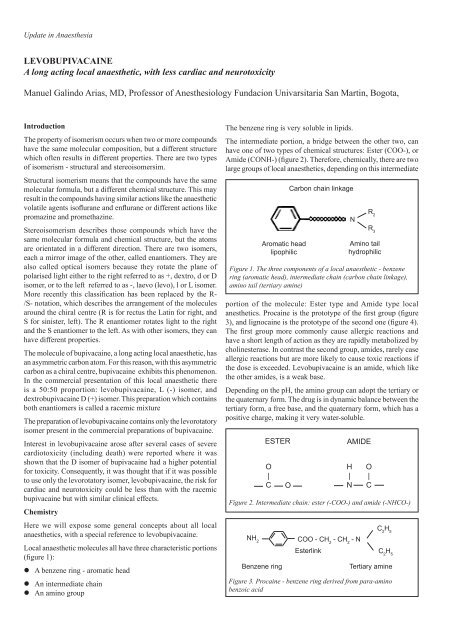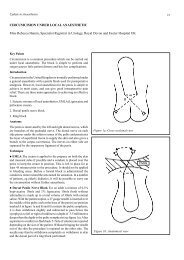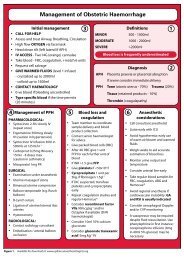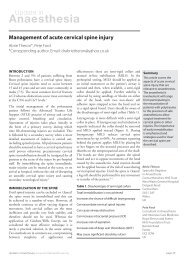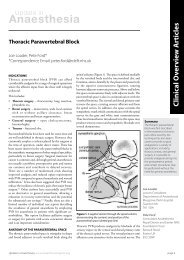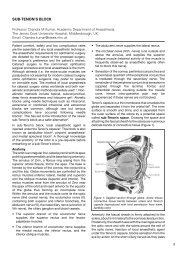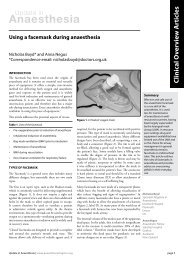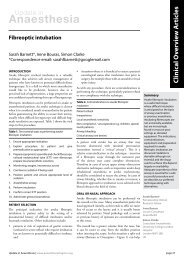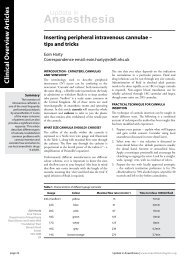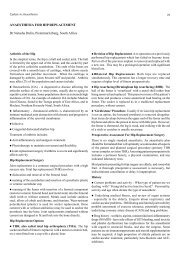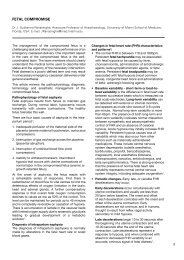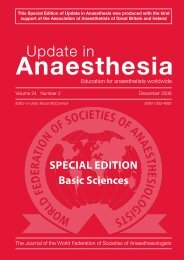LEVOBUPIVACAINE A long acting local anaesthetic, with less ...
LEVOBUPIVACAINE A long acting local anaesthetic, with less ...
LEVOBUPIVACAINE A long acting local anaesthetic, with less ...
Create successful ePaper yourself
Turn your PDF publications into a flip-book with our unique Google optimized e-Paper software.
Update in Anaesthesia 23<br />
<strong>LEVOBUPIVACAINE</strong><br />
A <strong>long</strong> <strong>acting</strong> <strong>local</strong> <strong>anaesthetic</strong>, <strong>with</strong> <strong>less</strong> cardiac and neurotoxicity<br />
Manuel Galindo Arias, MD, Professor of Anesthesiology Fundacion Univarsitaria San Martin, Bogota,<br />
Introduction<br />
The property of isomerism occurs when two or more compounds<br />
have the same molecular composition, but a different structure<br />
which often results in different properties. There are two types<br />
of isomerism - structural and stereoisomersim.<br />
Structural isomerism means that the compounds have the same<br />
molecular formula, but a different chemical structure. This may<br />
result in the compounds having similar actions like the <strong>anaesthetic</strong><br />
volatile agents isoflurane and enflurane or different actions like<br />
promazine and promethazine.<br />
Stereoisomerism describes those compounds which have the<br />
same molecular formula and chemical structure, but the atoms<br />
are orientated in a different direction. There are two isomers,<br />
each a mirror image of the other, called enantiomers. They are<br />
also called optical isomers because they rotate the plane of<br />
polarised light either to the right referred to as +, dextro, d or D<br />
isomer, or to the left referred to as -, laevo (levo), l or L isomer.<br />
More recently this classification has been replaced by the R-<br />
/S- notation, which describes the arrangement of the molecules<br />
around the chiral centre (R is for rectus the Latin for right, and<br />
S for sinister, left). The R enantiomer rotates light to the right<br />
and the S enantiomer to the left. As <strong>with</strong> other isomers, they can<br />
have different properties.<br />
The molecule of bupivacaine, a <strong>long</strong> <strong>acting</strong> <strong>local</strong> <strong>anaesthetic</strong>, has<br />
an asymmetric carbon atom. For this reason, <strong>with</strong> this asymmetric<br />
carbon as a chiral centre, bupivacaine exhibits this phenomenon.<br />
In the commercial presentation of this <strong>local</strong> <strong>anaesthetic</strong> there<br />
is a 50:50 proportion: levobupivacaine, L (-) isomer, and<br />
dextrobupivacaine D (+) isomer. This preparation which contains<br />
both enantiomers is called a racemic mixture<br />
The preparation of levobupivacaine contains only the levorotatory<br />
isomer present in the commercial preparations of bupivacaine.<br />
Interest in levobupivacaine arose after several cases of severe<br />
cardiotoxicity (including death) were reported where it was<br />
shown that the D isomer of bupivacaine had a higher potential<br />
for toxicity. Consequently, it was thought that if it was possible<br />
to use only the levorotatory isomer, levobupivacaine, the risk for<br />
cardiac and neurotoxicity could be <strong>less</strong> than <strong>with</strong> the racemic<br />
bupivacaine but <strong>with</strong> similar clinical effects.<br />
Chemistry<br />
Here we will expose some general concepts about all <strong>local</strong><br />
<strong>anaesthetic</strong>s, <strong>with</strong> a special reference to levobupivacaine.<br />
Local <strong>anaesthetic</strong> molecules all have three characteristic portions<br />
(figure 1):<br />
l A benzene ring - aromatic head<br />
l An intermediate chain<br />
l An amino group<br />
The benzene ring is very soluble in lipids.<br />
The intermediate portion, a bridge between the other two, can<br />
have one of two types of chemical structures: Ester (COO-), or<br />
Amide (CONH-) (figure 2). Therefore, chemically, there are two<br />
large groups of <strong>local</strong> <strong>anaesthetic</strong>s, depending on this intermediate<br />
Figure 1. The three components of a <strong>local</strong> <strong>anaesthetic</strong> - benzene<br />
ring (aromatic head), intermediate chain (carbon chain linkage),<br />
amino tail (tertiary amine)<br />
portion of the molecule: Ester type and Amide type <strong>local</strong><br />
anesthetics. Procaine is the prototype of the first group (figure<br />
3), and lignocaine is the prototype of the second one (figure 4).<br />
The first group more commonly cause allergic reactions and<br />
have a short length of action as they are rapidly metabolized by<br />
cholinesterase. In contrast the second group, amides, rarely case<br />
allergic reactions but are more likely to cause toxic reactions if<br />
the dose is exceeded. Levobupivacaine is an amide, which like<br />
the other amides, is a weak base.<br />
Depending on the pH, the amino group can adopt the tertiary or<br />
the quaternary form. The drug is in dynamic balance between the<br />
tertiary form, a free base, and the quaternary form, which has a<br />
positive charge, making it very water-soluble.<br />
Figure 2. Intermediate chain: ester (-COO-) and amide (-NHCO-)<br />
NH 2<br />
Aromatic head<br />
lipophilic<br />
O<br />
|<br />
C O<br />
Carbon chain linkage<br />
ESTER AMIDE<br />
H<br />
|<br />
N<br />
COO - CH 2 - CH 2 - N<br />
Esterlink<br />
O<br />
|<br />
C<br />
C 2 H 5<br />
C 2 H 5<br />
Benzene ring Tertiary amine<br />
Figure 3. Procaine - benzene ring derived from para-amino<br />
benzoic acid<br />
N<br />
R 2<br />
R 3<br />
Amino tail<br />
hydrophilic
24<br />
CH3 NHCO - CH - N 2<br />
Amide link<br />
CH3 C 2 H 5<br />
C 2 H 5<br />
Benzene Ring Tertiary amine<br />
Figure 4. Lignocaine - benzene ring derived from xylidine<br />
The pKa of levobupivacaine is 8.1, similar to the pKa of the<br />
racemic bupivacaine. (pKa is the pH at which 50 % of the<br />
molecules are free base and 50 % of the molecules have a positive<br />
charge - ionised)<br />
If bicarbonate is added to levobupivacaine, the pH is increased<br />
leading to a rise in the percentage of free base molecules. Those<br />
molecules cross more easily through the axon membrane and the<br />
pharmacological action begins more quickly.<br />
In contrast, if the pH is low (acid), as happens when there is a<br />
<strong>local</strong> infection, there will be <strong>less</strong> free base molecules to cross the<br />
axon membrane resulting in smaller action over the axon.<br />
Protein binding of levobupivacaine is more than 97%, mainly<br />
to acid alpha1-glycoprotein, rather than to albumin. This union<br />
to proteins is somewhat higher than the union of racemic<br />
bupivacaine to proteins (95%). This means that <strong>less</strong> than 3% is<br />
free in plasma. It is the free levobupivacaine, a small fraction of<br />
the total concentration that can have an action on other tissues,<br />
causing the unwanted side-effects, and producing the toxic<br />
manifestations. In hypo-proteinaemic, undernourished patients,<br />
patients <strong>with</strong> the nephrotic syndrome and in the newborn there<br />
is <strong>less</strong> protein for binding, causing higher levels of free drug,<br />
resulting in toxic effects being seen at lower doses<br />
Bupivacaine has stereoisometric properties as explained earlier.<br />
Commercial production of levobupivacaine for clinical use<br />
was started because it was observed experimentally that the<br />
D isomer had a lower threshold for causing tachycardia and<br />
dysrhythmias, which include, AV block, QRS widening and<br />
ventricular tachycardia and fibrillation than either the L isomer<br />
or the racemic preparation.<br />
The levo isomer was used in rats and its effect was compared <strong>with</strong><br />
the dextro isomer. It was found that <strong>with</strong> doses of 2mg/kg, all<br />
the animals of the dextro group developed apnoea, bradycardia,<br />
hypotension and finally died. In contrast, no animal in the<br />
levobupivacaine group had apnoea and only 30% had a slight<br />
bradycardia. In sheep experiments in which racemic bupivacaine<br />
was administered in toxic quantities, it was found that the<br />
concentration of the dextro isomer was higher in the myocardium<br />
and brain than the concentration of the levo isomer.<br />
This work together <strong>with</strong> other similar studies, led the investigators<br />
to conclude that levobupivacaine was <strong>less</strong> toxic than the racemic<br />
bupivacaine, but <strong>with</strong> similar clinical activity. Additionally,<br />
electrophysiological studies have been made which demonstrate<br />
that blockade of the inactive sodium channels is stereoselective,<br />
<strong>with</strong> the D isomer being more potent and faster than the L<br />
Update in Anaesthesia<br />
isomer. As this includes the cardiac fibres, it explains the higher<br />
cardiotoxicity associated <strong>with</strong> the D isomer. 1<br />
Some of the first clinical studies in humans in Brazil, compared<br />
the effects of the racemic preparation and the levo isomer of<br />
bupivacaine when given peridurally. No significant difference<br />
in onset time, quality of anaesthesia and level of blockade has<br />
been found.<br />
Pharmacokinetics<br />
There are difficulties in carrying out pharmacokinetic studies<br />
<strong>with</strong> bupivacaine. Classic pharmacokinetic studies are usually<br />
performed using an intravenous application of the drug. These<br />
studies are more accurate because there are fewer possible<br />
causes of error, than when other access routes are used, such<br />
as intramuscular or subcutaneous infiltration. With both these<br />
routes of administration, the rate of absorption is an important but<br />
unknown factor affecting the rate of absorption between patients<br />
<strong>with</strong> different pathologies. In addition intravenous administration<br />
of bupivacaine or levobupivacaine, for pharmacokinetic studies<br />
has limitations, because of the risk of fatal toxicity. Additionally,<br />
in clinical practice this drug is not used intravenously.<br />
Practical clinical studies have been carried out giving the drug for<br />
epidural and regional blocks. Placental transfer of levobupivacaine<br />
is similar to that of bupivacaine resulting in lower risk to the fetus.<br />
Like racemic bupivacaine, levobupivacaine is metabolised in the<br />
liver, primarily by the cytochrome P450, specially the CYP1A2<br />
and CYP3A4 isoforms. Clearance is reduced when the hepatic<br />
function is damaged.<br />
Pharmacodynamics<br />
The mechanism of action of levobupivacaine is exactly the<br />
same as that of racemic bupivacaine and that of all the <strong>local</strong><br />
anesthetic drugs in clinical use today. When the minimum <strong>local</strong><br />
analgesic concentration (MLAC) close to the membranes of the<br />
axons is reached, the molecules block the sodium channels, in<br />
the resting position. In this way, the transmission of the nerve<br />
impulses stops.<br />
This action is produced <strong>with</strong> an onset very similar to that of<br />
racemic bupivacaine. The duration of action is also similar to<br />
that of the racemic substance.<br />
Recent research work has been directed at the toxicity associated<br />
<strong>with</strong> the levo isomer, and how it compares <strong>with</strong> the racemic<br />
preparation. Differences were found between the two isomers.<br />
The concentration necessary to produce cardiac and neurotoxicity<br />
is higher for levobupivacaine than for racemic bupivacaine. The<br />
safety margin is estimated at 1.3 which means that toxic effects<br />
are not seen until the concentration rises by 30%<br />
Toxicity<br />
Volunteers have been given bupivacaine or levobupivacaine<br />
intravenously at a rate of 10mg/min, until the appearance of<br />
early symptoms of central nervous system toxicity. These<br />
appeared at a lower dose (Mean 47.1mg) <strong>with</strong> bupivacaine than<br />
<strong>with</strong> levobupivacaine (56.1mg). Similarly there was a greater<br />
reduction in the myocardial ejection fraction and systolic and<br />
acceleration index <strong>with</strong> racemic bupivacaine when compared<br />
to levobupivacaine. When 40mg of either levobupivacaine or
Update in Anaesthesia 25<br />
racemic bupivacaine were administered over a 10min period, the<br />
EEG was significantly slower after racemic bupivacaine. Thus<br />
at similar doses, electrical activity is more affected by racemic<br />
bupivacaine. 2<br />
Levobupivacaine appears to cause <strong>less</strong> myocardial depression<br />
than both bupivacaine and ropivacaine, despite being in higher<br />
concentrations.<br />
Clinical Applications<br />
Levobupivacaine has been introduced into clinical practice<br />
<strong>with</strong>in the last few years. It has been used at all sites: epidural,<br />
subarachnoid, different levels of brachial plexus block -<br />
interscalene, supra and infraclavicular, intercostal and peripheral<br />
nerve blockade, peribulbar and retrobulbar blockade, <strong>local</strong><br />
infiltration, obstetric analgesia, postoperative pain management,<br />
acute and chronic pain management. The doses used are very<br />
similar to those of bupivacaine. As a result of its lower cardiac and<br />
neurotoxicity compared to racemic bupivacaine, anaesthetists feel<br />
safer working <strong>with</strong> levobupivacaine, than <strong>with</strong> bupivacaine.<br />
Neverthe<strong>less</strong>, we must always remember that it is still a<br />
potentially toxic <strong>local</strong> <strong>anaesthetic</strong>. The initial licensing authority<br />
recommended a maximum single dose of 2mg/kg, and 400mg<br />
(5.7mg/kg) in 24h. Since then, some studies have shown that<br />
higher doses are safe, but further work is required. Special<br />
caution is recommended for hypoproteinemic patients, including<br />
adults <strong>with</strong> nephrotic syndrome, severe hepatic disease and the<br />
newborn.<br />
In Colombia, we have been using this new <strong>local</strong> <strong>anaesthetic</strong> for a<br />
year, <strong>with</strong> excellent results. 3 We only have the 0.75% formulation<br />
and use almost the same dose as when using bupivacaine. We have<br />
had no reports of toxic reactions. During the Colombian Congress<br />
of Anesthesiology (2001), a paper was presented, comparing<br />
levo-bupivacaine <strong>with</strong> ropivacaine in epidural anaesthesia. The<br />
two drugs were comparable, <strong>with</strong> a very good quality of epidural<br />
anaesthesia. However there were three cases of bradycardia in<br />
the levobupivacaine group which were treated successfully <strong>with</strong><br />
atropine. The duration of the motor blockade in the postoperative<br />
period was <strong>less</strong> than after racemic bupivacaine.<br />
Adverse Effects<br />
These are the same as caused by racemic bupivacaine and any<br />
other <strong>local</strong> <strong>anaesthetic</strong>. They include hypotension, bradycardia,<br />
nausea, vomiting, pruritus, headache, tinnitus, dizziness,<br />
constipation, vomiting and convulsions.<br />
There have been reports of cases where the drug has been given in<br />
higher doses than that recommended, <strong>with</strong> no apparent toxicity. In<br />
one case, a single dose of levobupivacaine of 250mg for a brachial<br />
plexus block, far exceeding the maximum recommended dose<br />
(150mg), <strong>with</strong>out toxicity symptoms, although further data will be<br />
needed before the safety of this level of dosage is confirmed.<br />
There is a report where approximately 1.7mg/kg racemic<br />
bupivacaine was injected probably by an accidental intravenous<br />
injection during an attempted supraclavicular brachial plexus<br />
block. The patient lost consciousness, developed a tachycardia,<br />
hypertension and generalized twitching, was managed <strong>with</strong><br />
oxygen and propofol, <strong>with</strong> a successful recovery after a few<br />
minutes <strong>with</strong> no sequelae. 4 The authors stressed the risks<br />
associated <strong>with</strong> administration of high doses of bupivacaine, even<br />
in experienced hands and underline the need for possibly safer<br />
agents such as levobupivacaine.<br />
Conclusion<br />
Levobupivacaine is a relatively new <strong>long</strong> <strong>acting</strong> <strong>local</strong> <strong>anaesthetic</strong>,<br />
<strong>with</strong> a pharmacological activity very similar to that of racemic<br />
bupivacaine. The first studies in humans confirm the animal<br />
studies and the in vitro studies, which showed that this new<br />
molecule is <strong>less</strong> cardiotoxic and <strong>less</strong> neurotoxic than the racemic<br />
bupivacaine. Levobupivacaine can be used for all indications in<br />
which the anaesthetist needs a <strong>long</strong> <strong>acting</strong> <strong>local</strong> <strong>anaesthetic</strong>. The<br />
reduced toxicity of this new <strong>local</strong> <strong>anaesthetic</strong> is an advantage for<br />
the patient. The cost in Colombia is 40% higher, than racemic<br />
bupivacaine.<br />
References<br />
1. Tanelian DL. The new <strong>local</strong> anesthetics. Benefits, risk and use.<br />
Refresher Courses in Anesthesiology 1997;25:204-205<br />
2. Bardsley H, Gristwood R, Baker H: A comparison of the<br />
cardiovascular effects of levobupivacaine and racemic bupivacaine<br />
following intravenous administration to healthy volunteers.<br />
British Journal of Clinical Pharmacology 1998;46:245-249<br />
3. Martinez JC, Perilla C: Anestesia peridural para cirugía<br />
de miembro inferior. Comparación de levobupivacaina con<br />
ropivacaine. Revista Colombiana de Anestesiologia (in press)<br />
4. Cox CR, Checketts MR, MacKenzie N: Comparison of S(-)<br />
bupivacaine <strong>with</strong> racemic bupivacaine in supraclavicular brachial<br />
plexus block. British Journal of Anaesthesia 1998;80:594-8<br />
Further reading<br />
McLeod GA, Burke D. Levobupivacaine. Anaesthesia<br />
2001;56:331-341


